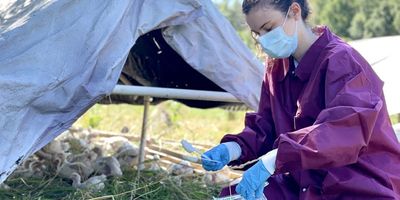Study Compares Salmonella Rates in Backyard, Commercial Poultry Farm Samples
As backyard farms grow in popularity, understanding the prevalence and spread of pathogens is crucial
In a comparison of differently sized poultry farms, researchers at North Carolina State University found that rates of Salmonella in fecal and environmental samples were more prevalent on larger commercial farms than on smaller backyard farms.
Perhaps more importantly, multidrug resistance was found in Salmonella samples from both types of production systems, even though antibiotics are not used on backyard farms and are only used sparingly on commercial farms.
The findings, published in Foodborne Pathogens and Disease, could help small and larger farms understand more about the spread of Salmonella in their respective systems.
“We wanted to look at backyard broiler farms; broilers are chickens that are raised for meat consumption rather than egg consumption,” said Jessica Parzygnat, an NC State PhD graduate and first author of the paper. “Broiler chickens are the top consumed meat in the US and the world, but there’s not much research on backyard farms, which are growing in popularity in the US.
“The Centers for Disease Control has been issuing warnings on Salmonella outbreaks from backyard poultry farms in the last several years, so we wanted to see what pathogens are on backyard farms but also compare that to commercial farms.”
Researchers tested 10 backyard and 10 commercial flocks. The smallest backyard flock was 22 birds, and the largest was 1,000 birds; all backyard farm birds lived outdoors. Commercial farms, meanwhile, had tens of thousands of birds that lived indoors.
The researchers tested bird fecal samples, as well as environmental conditions like litter, soil, and feeders, for the presence of Salmonella, in addition to other pathogens. Researchers also examined compost samples on backyard farms.
“We tried to examine where Salmonella is prevalent on farms through testing bird fecal samples and also the environment around them,” Parzygnat said. “We found less Salmonella on backyard farms (19.1 percent of samples) than commercial farms (52.3 percent of samples). We expected that, because previous studies had shown low rates of Salmonella on backyard farms. At the same time, our rates of Salmonella in samples on backyard farms were higher than in other studies looking at backyard poultry in the US.
“Both types of farm managers need to be careful with their birds,” Parzygnat continued. “There’s a feeling that backyard birds are safer than commercial birds, but even though we found less Salmonella, the proportion of Salmonella in backyard farms and commercial farms that were multidrug resistant—meaning that they showed resistance to three or more classes of antibiotics—was actually not significantly different.”
Parzygnat says that common-sense prevention measures can help consumers avoid Salmonella effects, including cooking chicken thoroughly and avoiding cross-contamination while handling and preparing poultry.
“Salmonella can be natural inhabitants of the bird gastrointestinal tract, and the birds won't really show signs of illness,” she said. “I think one of the major concerns my research highlights is the antibiotic resistance associated with it because that really heightens the concern of infection.”
- This press release was originally published on the NC State University website and has been edited for style and clarity

